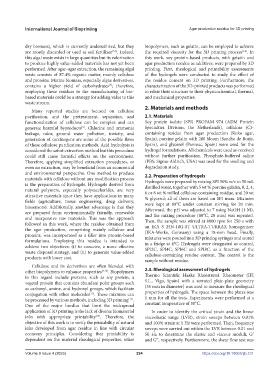Page 232 - IJB-9-4
P. 232
International Journal of Bioprinting Agar production residue for 3D printing
dry biomass), which is currently underutilized, but they biopolymers, such as gelatin, can be employed to achieve
are mostly discarded or used as soil fertilizer [5,6] . Indeed, the required viscosity for the 3D printing process . In
[14]
this algal waste exists in large quantities but its valorization this work, soy protein-based products, with gelatin and
to produce highly value-added materials has not yet been agar production residue as additives, were prepared by 3D
performed. After agar–agar extraction, the remaining algal printing. First, rheological and printability assessments
waste consists of 87.4% organic matter, mainly cellulose of the hydrogels were conducted to study the effect of
and proteins. Marine biomass, especially algae derivatives, the residue content on 3D printing. Furthermore, the
contains a higher yield of carbohydrates ; therefore, characterization of the 3D-printed products was performed
[7]
employing these residues in the manufacturing of bio- to relate their structure to their physicochemical, thermal,
based materials could be a strategy for adding value to this and mechanical properties.
waste stream.
Many reported studies are focused on cellulose 2. Materials and methods
purification, and the pretreatment, separation, and 2.1. Materials
functionalization of cellulose can be complex and can Soy protein isolate (SPI) PROFAM 974 (ADM Protein
generate harmful byproducts . Chlorine and ammonia Specialties Division, the Netherlands), cellulose (C)-
[8]
leakage, odor, ground water pollution, toxicity, and containing residue from agar production (Roko agar,
generation of carcinogens are some of the possible flaws Spain), porcine gelatin with 280 bloom (Sancho de Borja,
of these cellulose purification methods. Acid hydrolysis is Spain), and glycerol (Panreac, Spain) were used for the
considered the safest extraction method but this procedure hydrogel formulations. All chemicals were used as-received
could still cause harmful effects on the environment. without further purification. Phosphate-buffered saline
Therefore, applying simplified extraction procedures, or (PBS; Sigma-Aldrich, USA) was used for the swelling and
even no extraction, may be beneficial from an economical degradation study.
and environmental perspective. One method to produce 2.2. Preparation of hydrogels
materials with cellulose without any modification process Hydrogels were prepared by mixing SPI 50% w/v in 50 mL
is the preparation of hydrogels. Hydrogels derived from distilled water, together with 5 wt % porcine gelatin, 0, 2, 4,
natural polymers, especially polysaccharides, are very 6 or 8 wt % milled cellulose-containing residue, and 20 wt
attractive materials since they have applications in many % glycerol; all of them are based on SPI mass. Mixtures
fields (agriculture, tissue engineering, drug delivery, were kept at 80°C under constant stirring for 20 min.
biosensors). Additionally, another advantage is that they Afterward, the pH was adjusted to 7 using NaOH (1 M),
are prepared from environmentally friendly, renewable and the mixing procedure (80°C, 20 min) was repeated.
and inexpensive raw materials. This was the approach Then, the sample was stirred at 8000 rpm for 250 s with
followed in this work, where the residue obtained from an IKA S 25N-18G-ST ULTRA-TURRAX homogenizer
the agar production, comprising mainly cellulose and (IKA-Werke, Germany) using a 18-mm head. Finally,
proteins, was incorporated as a filler into protein-based mixtures were poured into 3D printing syringes and stored
formulations. Employing this residue is intended to in a fridge at 4°C. Hydrogels were designated as control,
achieve two objectives: (i) to conceive, a more effective SPI2C, SPI4C, SPI6C and SPI8C, as a function of the
waste disposal strategy, and (ii) to generate value-added cellulose-containing residue content. The control is the
products with lower cost.
sample without residue.
Cellulose and its derivatives are often blended with
other biopolymers to enhance properties [9,10] . Biopolymers 2.3. Rheological assessment of hydrogels
in this regard include proteins, such as soy protein, a Thermo Scientific Haake Rheostress1 Rheometer (IFI
vegetal protein that contains abundant polar groups such S.L., Vigo, Spain) with a serrated plate-plate geometry
as carboxyl, amine, and hydroxyl groups, which facilitate (35 mm in diameter) was used to measure the rheological
conjugation with other molecules . These mixtures can properties of hydrogels. The space between the plates was
[11]
be processed by various methods, including 3D printing . 1 mm for all the tests. Experiments were performed at a
[12]
One of the major hurdles that limit the widespread constant temperature of 30°C.
application of 3D printing is the lack of diverse biomaterial In order to identify the critical strain and the linear
inks with appropriate printability . Therefore, the viscoelastic range (LVR), strain sweeps between 0.01%
[13]
objective of this work is to verify the printability of natural and 100% strain at 1 Hz were performed. Then, frequency
inks developed from agar residue in line with circular sweeps were carried out within the LVR between 0.01 and
economy principles. Considering that printability is 50 Hz to determine the elastic and viscous moduli, G′
dependent on the material rheological properties, other and G″, respectively. Furthermore, the shear flow test was
Volume 9 Issue 4 (2023) 224 https://doi.org/10.18063/ijb.731

